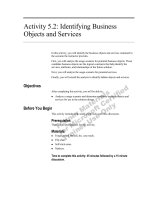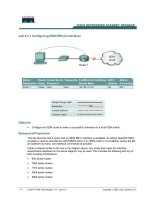Tài liệu Activity 4.2: Creating a Logical Data Model ppt
Bạn đang xem bản rút gọn của tài liệu. Xem và tải ngay bản đầy đủ của tài liệu tại đây (96.38 KB, 4 trang )
Activity 4.2: Creating a Logical Data
Model
In this activity, you will use the skills learned in this module to define the
relationships within a logical data model and produce a sample ER diagram for
the Ferguson and Bardell, Inc. case study.
In each of the two exercises in this activity, you analyze a single aspect of a
logical data design. At the end of each exercise, the class will discuss the design
you derived.
Objectives
After completing this activity, you will be able to:
!
Identify relationships between entities.
!
Create a logical data model.
Before You Begin
This activity will take place in small groups with a class discussion following
completion of the activity.
Prerequisites
!
To complete this activity, you need the entities identified in Activity 4.1.
Time to complete this activity: 20 minutes
18 Activity 4.2: Creating a Logical Data Model
Exercise 1:
Identifying Relationships Between Entities
In this exercise, you will identify all the relationships between the entities
defined in Activity 4.1.
!
Identify relationships between entities
1. Join the group to which you have been assigned by the instructor.
2. Review the entities identified in Activity 4.1. Draw a box for each entity in
the space below, and label the box with the entity’s name.
3. Place the attributes you identified in Activity 4.1 in the boxes of the
corresponding entities.
4. Draw a line between any entities that have relationships.
5. Identify verbs or actions that define the relationship between each pair of
entities, and label the line with the relationship verb.
This is the initial ER diagram for the logical data model.
Answer in v04_1609a_act42-1.bmp
Activity 4.2: Creating a Logical Data Model 19
Exercise 2:
Determining Cardinality and Existence
In this exercise, you will use the syntax discussed in the module to identify the
cardinality and existence characteristics of each of the relationships defined in
Exercise 1.
!
Identify cardinality
1. For each relationship on your ER diagram, ask the question “How many of
the parent entity work with how many of the child entity?”
This question will help you determine whether the cardinality of each
relationship is one-to-one, one-to-many, or many-to-many.
2. Use the syntax discussed in the module to record the cardinality of each
relationship and denote the entities as parent or child.
!
Identify existence
!
For each relationship on your ER diagram, ask the question “Can the child
exist if the parent does not exist?”
• If the answer is “Yes,” existence is optional. Denote the relationship
with a dashed (broken) line.
• If the answer is “No,” existence is mandatory. Denote the relationship
with a solid line.
Answer in v04_1609a_act42-2.bmp
Next, you will present your findings to the class.
THIS PAGE INTENTIONALLY LEFT BLANK









